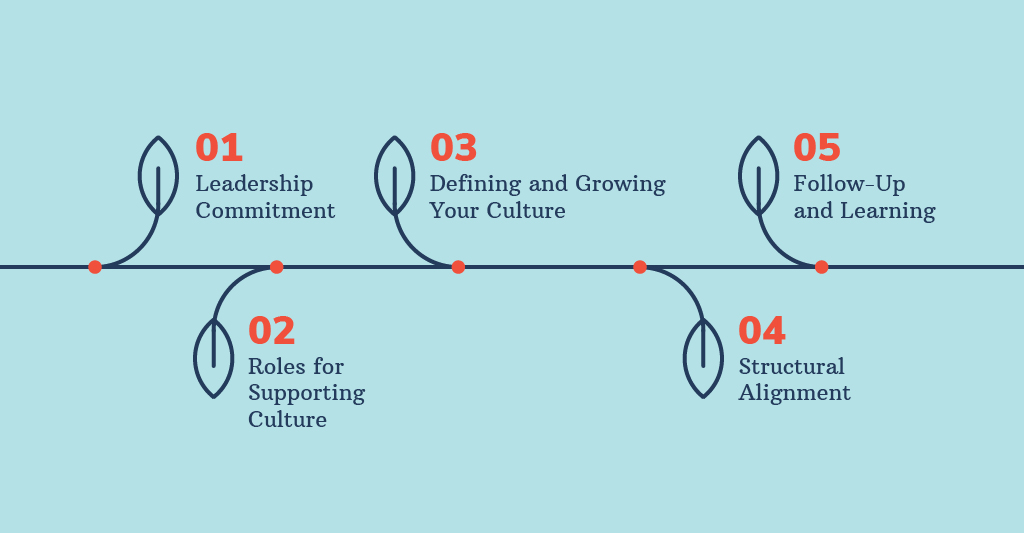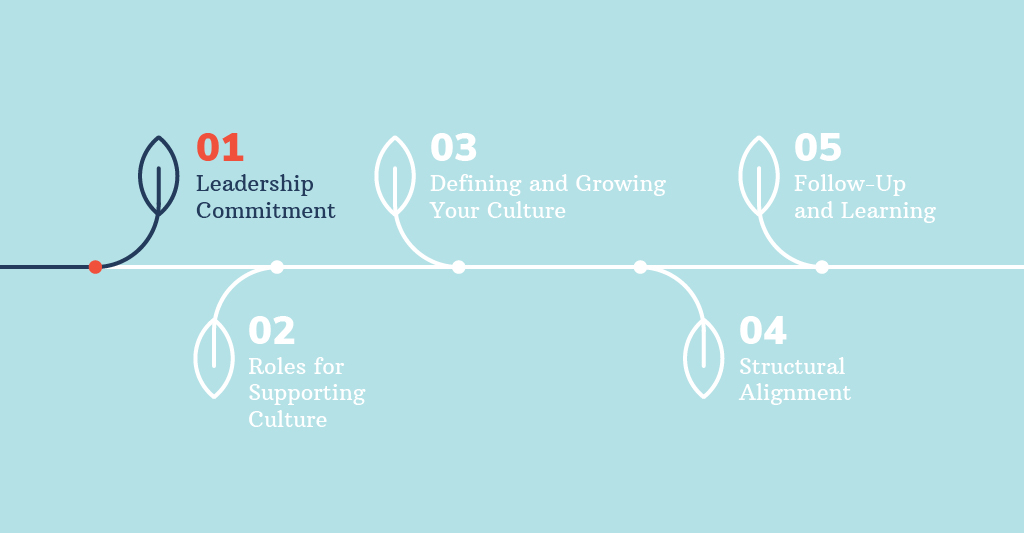
It takes intention, planning, time, attention, and adjustments based on conditions. There is no prescriptive linear way to do this; however, we’ve identified five areas for growing your desired culture:

Each of these areas takes attention and planning, so it’s important to select just a few to focus on at a time. To begin your journey into organizational culture, this and my next four articles will go deeper into each area, but we encourage you to highlight three to five vital activities that are relevant to your organization in the next three months. Revisit the list every three months to review your accomplishments and identify the next vital activities to focus on.

-
Leadership Commitment
Everyone knows that leadership is essential to transform a culture, but often the roles and responsibilities are not entirely clear. Here are some tips to create a transformational leadership commitment at all levels of the organization.
ROLE OF CEO
It is critical for the CEO to be a transformational leader in guiding the organizational culture. Transformational leaders who are committed to culture talk passionately about it every day. They have personal and clear stories about why they are working with organizational culture. They are consistent and persistent in living the values and building the culture. They have low tolerance for people who are not working to better the culture. They walk their talk!
BOARD COMMITMENT
You will need buy-in and support from the most senior reporting team or structure for organization-wide success. This is often a corporate board. Organizational priorities are typically established from the top, and organizational culture must be included, especially since it is so critical and needs attention over a long period of time.
COMPELLING SHARED REASON
The top team should develop a compelling shared reason for working with organizational culture. This group should have a clear picture of where they are and where they want to go. They should understand the current culture and have a shared vision of the desired culture.
SELF-AWARENESS
All members of the top team should develop self awareness and know their values, purpose, personality, behaviors, and impact on the people around them. Each leader should also understand how they align with the desired organizational values and culture.
WALKING YOUR TALK
All members of the top team should develop ongoing awareness of and feedback on their behaviors, communications, and the perceptions of others.
INVOLVEMENT AND COMMITMENT
Develop a strategy and process to share your organizational culture and involve all your managers. The strategy should include programs for managers to increase their own personal awareness and expectations about their behaviors.
![]()
 In 2017, Ashley Munday, Former Director of Thrive by SweetRush, and Tor Eneroth, Director of Cultural Transformation at Barrett Values Centre, wrote an eBook as a resource and workbook for leaders to get started on the culture journey in a meaningful and tactical way. To accommodate as many leaders as possible, we have converted the content into a series of articles that can be read piece by piece and will be publishing them on a weekly basis. We invite you to consume the material at your own pace and welcome your feedback and questions along the way. Thrive by SweetRush is now known as Transforming Leaders and Culture (TLC) by SweetRush. Please reach out to begin transforming your organization today!
In 2017, Ashley Munday, Former Director of Thrive by SweetRush, and Tor Eneroth, Director of Cultural Transformation at Barrett Values Centre, wrote an eBook as a resource and workbook for leaders to get started on the culture journey in a meaningful and tactical way. To accommodate as many leaders as possible, we have converted the content into a series of articles that can be read piece by piece and will be publishing them on a weekly basis. We invite you to consume the material at your own pace and welcome your feedback and questions along the way. Thrive by SweetRush is now known as Transforming Leaders and Culture (TLC) by SweetRush. Please reach out to begin transforming your organization today!
![]()
If you’re reading this series, we know you are a leader who understands and cares about the way your organization’s culture supports its people and its purpose—for that, we thank you! Check out the other articles in this series:
- Culture Change in Organizations Begins Within
- Organizational Culture Transformation—A Journey, Not a Destination
- Culture Change Case Study: Volvo IT
- Changing Corporate Culture Case Study: Old Mutual Group
- Cultural Change In Organizations Example: Unilever Brazil
- Key Learnings in Culture Transformation
- Growing Your Desired Culture: Leadership Commitment
- Growing Your Desired Culture: Roles for Supporting Culture
- Growing Your Desired Culture: Defining and Growing Your Culture
- Growing Your Desired Culture: Structural Alignment
- Growing Your Desired Culture: Follow-Up and Learning




